|
|
A
Close-up View of the Bird's - Nest Weed (Daucus carota) |
|
|
A
Close-up View of the Bird's - Nest Weed (Daucus carota) |
During the summer months, the tall stalks of this elegant white
wildflower can be seen gracing the landscape near roadsides, and in
untended fields. Queen Anne’s Lace originated in Eurasia, and was
transported to North America in the seventeen and eighteen
hundreds. It is the ancestor of our cultivated carrot, and is
sometimes referred to as the “Wild
Carrot”.
However, unlike the cultivated variety, this plant has a white,
inedible taproot. The leaves are green and extremely feathery.
Queen Anne’s Lace undergoes a series of structural changes as it
matures and forms seeds. Each stage in the progression is
particularly striking in an architectural sense. Early blooms,
like the one below, are held aloft by a hollow tubular, bristly stem
that can be up to 1.5 metres high. (In the fall, perfectly
shaped, but dwarf plants often appear that are a mere 20 centimetres in
height.) At this stage, the outer flowers are much larger than
the inner ones, and display a pink colour. A whorl of forked
green bracts, (modified
leaves), frames the flowering head.

The many flowers are arranged in a concave, bowl-like structure.

At a
slightly later stage, the flower-head flattens out to form the slightly
convex shape seen below.


Each small group of flowers is called an umbelet, and has the
characteristic concave shape of the early stage plant. Notice how
the larger pink flowers are always located away from the centre of the
overall flower-head.


A side view reveals a brown elliptical structure at the base of each
flower.

This structure is the bristly immature ovary. When the petals and
stamens are attached to the top of the ovary, as seen in the photograph
below, the ovary is called “inferior”.
In many flowers, the ovary is above, and cupped by, the
petals. This is referred to as a “superior” ovary.


Over a period of a week or two, the entire flower-head increases in
size, and strangely loses its pink colouration. Notice the
development at this stage of a single deep purple flower at the very
centre of the head. This is an important distinguishing
characteristic of mature Queen Anne’s Lace, and is present in most
plants.

Eventually, all pink colouration disappears, and the mature flower-head
is revealed with its tiny purple flower at the centre. The fine,
intricate detail is probably the reason that the plant was thought to
resemble the lace produced by “Good Queen Anne”. Each 6 to 15 cm
diameter flower-head contains many hundreds of flowers. The view
from the underside of the flower-head shows that many white stalks
radiate out from a central point of attachment to the main stalk.
These stalks form the “umbel”,
and in turn act as starting points for a second series of smaller
radial stalks called the “umbelet”.
(These umbelets can also be seen in the first image in the article.)


A Queen Anne’s Lace umbel is framed on the underside by a beautiful
whorl of finely divided green bracts. These bracts contribute
greatly to the architectural nature of the flower-head.


On the front of the flower-head, the single very deep purple flower
stands out clearly against the backdrop of smaller white blooms.


Each of the flowers consists of five white petals, five stamens, and
two styles.

An image of the underside of one of the umbelets can be seen below.
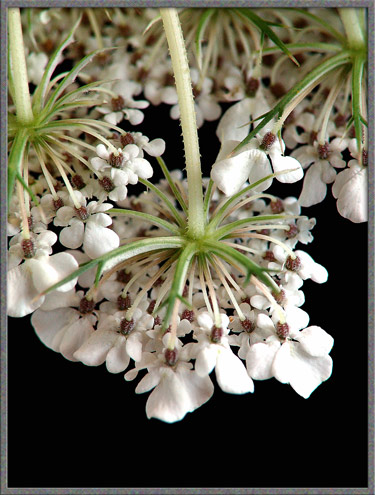
Under the microscope, the parts of a flower are revealed more
clearly. Notice the two pale green styles projecting upwards, and
the orange-yellow ovary at the base.
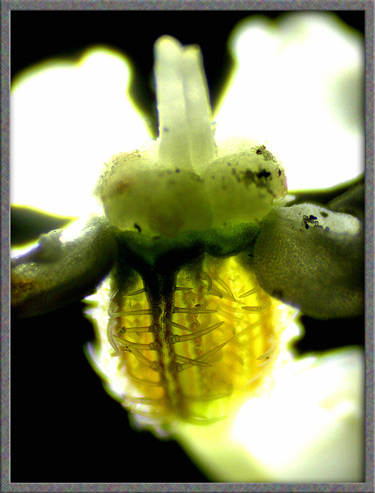
The details of the two styles,
(part of the pistil connecting the stigma to the ovary), can be seen
below. The stigma,
(female pollen accepting organ), is the globular expansion at the end
of each stalk.
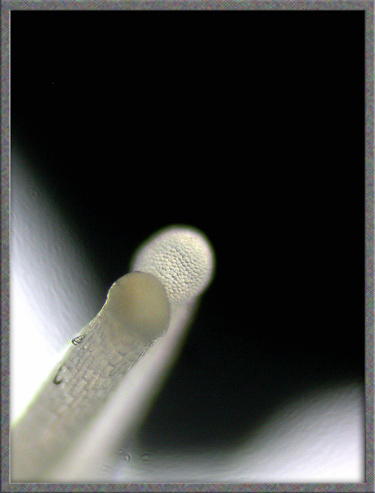
Ridges on the ovary carry many spike-like bristles.
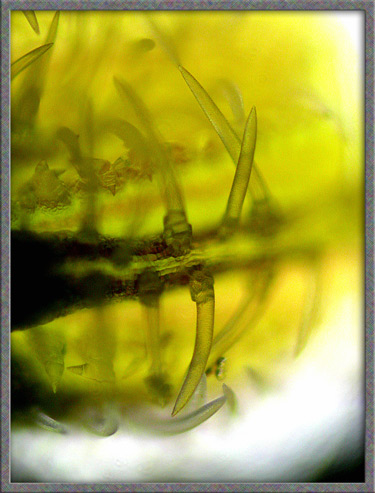
Under higher magnification, the rough surface of a spike is evident.
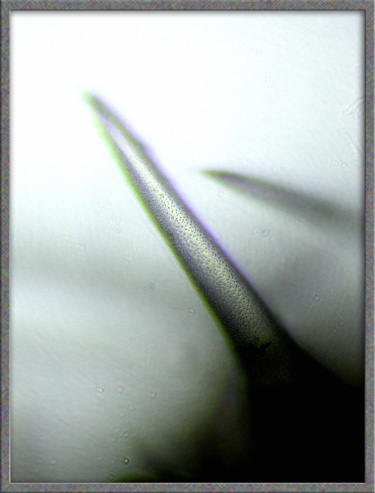
Earlier in the article, I mentioned that Queen Anne’s Lace undergoes
structural changes during its life cycle. After pollination by
insects, the fruiting umbels and stems curve inward to form a cup
shape. This shape probably inspired one of the other common names
for this plant, “Bird’s-Nest Weed”.
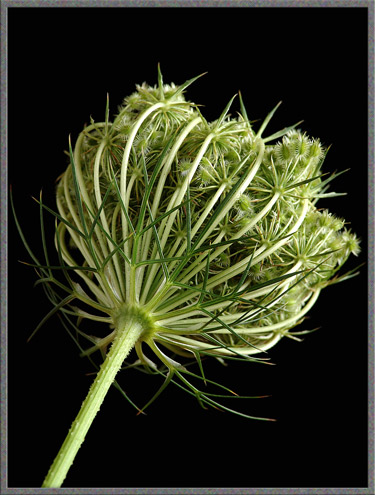
Immediately after the shape change, the fruit is a pale green colour.
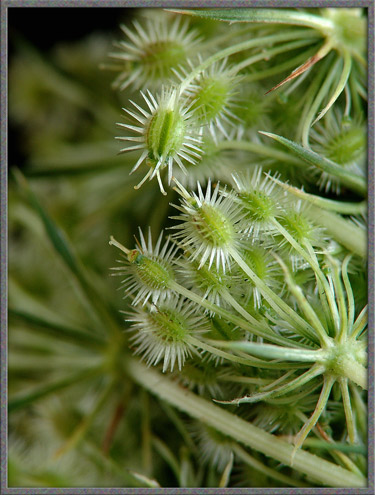
Each 2 to 4 mm long fruit is a bristly elliptical structure called a schizocarp
which eventually splits into two seeds, one for each stigma-style
combination. The two styles are clearly visible in each of the
schizocarps shown in the following images. Notice that the
bristles are positioned along the darker purple longitudinal ridges.
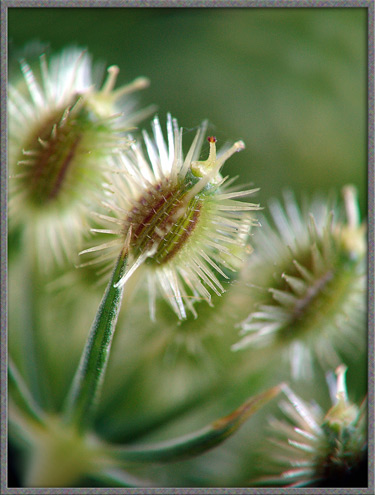
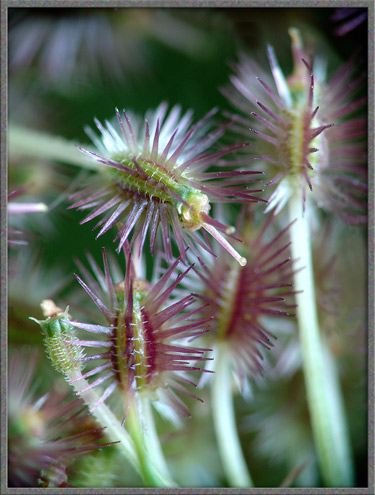
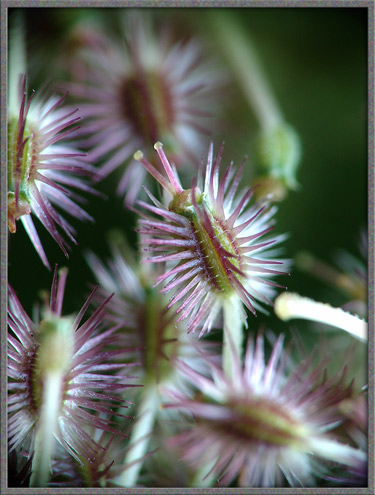
At a still later stage, the fruit takes on a much darker purple colour,
and stands out clearly from the pale green umbelet stalks. (The
interior of the cup seems to be a favourite resting place for insects.)
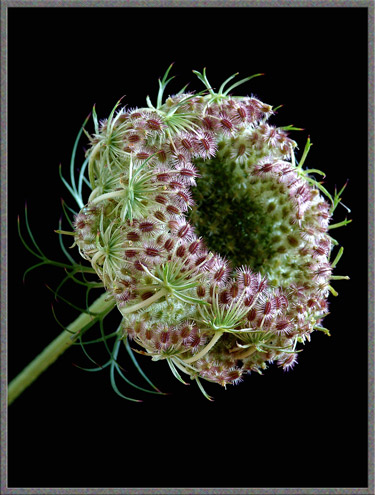
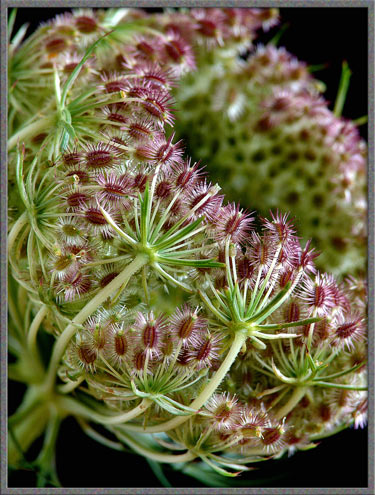
Now, the entire fruit is a dark purplish-brown colour.
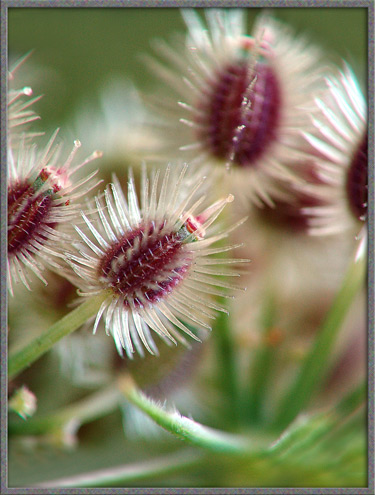
In late September and early October, the plant begins to dry out, and
the outermost schizocarps split and fall to the ground.
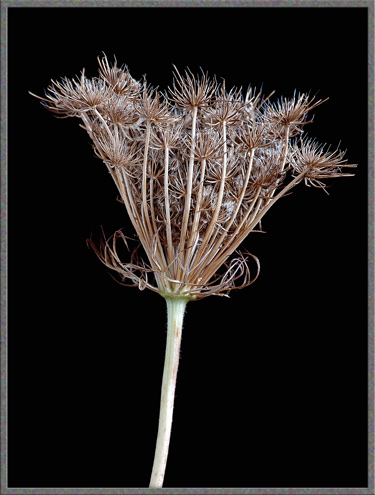
A few whole schizocarps remain, protected within the cup structure.
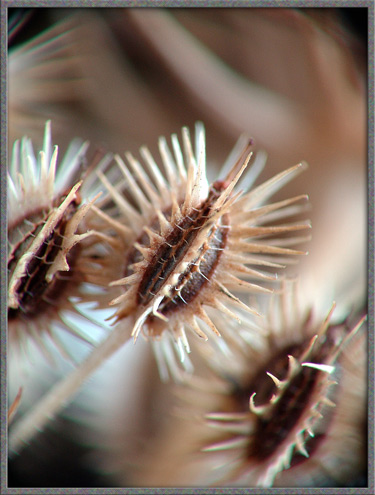
Although Queen Anne’s Lace is not a colourful plant, it does possess a
striking structural beauty when viewed close-up. The next
time you see one of these plants in bloom, have a good look. It
may surprise you!
Photographic
Equipment
The photographs in the article were
taken with an eight megapixel Sony CyberShot DSC-F 828 equipped with
achromatic close-up lenses (Nikon 5T, 6T, Sony VCL-M3358, and shorter
focal length achromat) used singly or in combination. The lenses screw
into the 58 mm filter threads of the camera lens. (These produce
a magnification of from 0.5X to 10X for a 4x6 inch image.) Still
higher magnifications were obtained by using a macro coupler (which has
two male threads) to attach a reversed
50 mm focal length f 1.4 Olympus SLR lens to the F 828. (The
magnification here is about 14X for a 4x6 inch image.) The
photomicrographs were taken with a Leitz SM-Pol microscope (using dark
ground and polarizing condensers), and the Coolpix 4500.
References
The following references have been
found to be valuable in the identification of wildflowers, and they are
also a good source of information about them.
Published in the April
2005 edition of Micscape.
Please report any Web problems or
offer general comments to the Micscape
Editor.
Micscape is the on-line monthly magazine
of the Microscopy UK web
site at Microscopy-UK
© Onview.net Ltd, Microscopy-UK, and all contributors 1995 onwards. All rights reserved. Main site is at www.microscopy-uk.org.uk with full mirror at www.microscopy-uk.net .